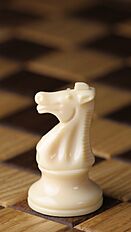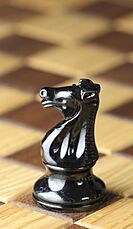Knight (chess) facts for kids
The knight (♘, ♞) is a special piece in the game of chess. It looks like a horse's head and neck. Knights move in a unique "L" shape, jumping over other pieces. Each player starts a game with two knights. They are placed on the 'b' and 'g' files, between a rook and a bishop.
Contents
How Does the Knight Move?
The knight's move is very special compared to other chess pieces. It moves two squares in one direction (up, down, left, or right) and then one square in a direction that is perpendicular to the first move. This creates an "L" shape. For example, it can move two squares forward and then one square to the side. Or, it can move two squares to the side and then one square forward.
Because of this "L" shape move, a knight always lands on a square of the opposite color from where it started. If it starts on a light square, it will land on a dark square, and vice versa.
A cool thing about the knight is that it can jump over other pieces! No other chess piece can do this. It doesn't matter if there are pieces in the way; the knight just leaps over them to its destination. Knights capture enemy pieces by landing on their square and taking them off the board.
A knight can have up to eight possible moves at once, especially when it's in the middle of the board. At the very start of a chess game, only knights and pawns can be moved.
How Valuable is a Knight?
Knights and bishops are often called minor pieces. In terms of value, a knight is usually worth about three pawns.
Knights are especially strong in closed positions. These are positions where many pieces block the board, and it's hard for pieces like rooks or bishops to move far. Since knights can jump over other pieces, they are very useful in these situations.
Knights become more powerful when they move forward and are supported by other pieces, like pawns. This helps them create strong positions called outposts. Generally, a knight is strongest when it's in the center of the board. From the center, it can reach up to eight different squares. It is weakest in a corner, where it can only reach two squares.
Knight's Special Abilities
Enemy pawns can be very good at attacking knights. This is because a pawn attacking a knight cannot be attacked back by the knight. This makes knights very effective when they are placed in a weak spot in the opponent's pawn structure. A weak spot is a square that enemy pawns cannot attack.
For example, in the diagram below, White's knight on d5 is very strong. It's even stronger than Black's bishop on g7!
While two bishops often work well together, two knights don't usually help each other as much. Because of this, having two bishops is generally thought to be better than having two knights.
In the endgame (the final part of the game), if there are no other pieces or pawns, two knights can sometimes create a drawing position called a fortress against a queen. This is harder for two bishops or a bishop and a knight to do.
Knights in the Endgame
Compared to a bishop, a knight is often not as good in the endgame. A knight can only control one part of the board at a time. It also takes several moves to get a knight to a new spot. This makes knights less useful in endgames where pawns are on both sides of the board. However, this problem is smaller if pawns are only on one side of the board. Knights are actually better than bishops in endgames if all the pawns are on one side.
Also, knights can control squares of both colors, which is an advantage over a single bishop. A bishop is stuck on squares of only one color.
However, a knight has one disadvantage: it cannot "lose a move" to put the opponent in zugzwang. This is a situation where any move an opponent makes will make their position worse. A bishop can do this, but a knight cannot.
In an endgame where one side has only a king and a knight, and the other side has only a king, the game is a draw. This is because a checkmate is impossible with just a king and one knight.
If one side has a king and two knights against a lone king, a checkmate cannot be forced mate|forced. Checkmate can only happen if the opponent makes a mistake. However, checkmate can be forced with a bishop and knight or with two bishops.
Stamma's Mate: A Rare Checkmate
In some rare endgame positions, a special checkmate pattern called Stamma's mate can happen. This is when the enemy king is trapped in a corner, often behind its own pawn. It's possible to force a checkmate with just a king and a knight in these specific situations.
One famous example comes from a game between Nogueiras and Gongora in 2001. Black made a mistake, thinking the game would be a draw. But White's knight was able to force a checkmate.
How Do We Write Down Knight Moves?
In algebraic notation, which is the most common way to record chess games today, the letter N stands for the knight. The letter 'K' is saved for the king. In older chess books, you might sometimes see 'Kt' used for the knight.
In chess puzzles and studies, the letter S is often used. This comes from "Springer," which is the German word for knight, meaning "jumper."
Knight's History
The knight's movement is the oldest of any chess piece! It was first used in an Indian game called chaturanga around the 6th century. Its move has not changed since then.
Knight-like Pieces in Other Games
Pieces similar to the knight are found in almost all games that are part of the chess family.
- The ma in xiangqi and janggi moves a bit like a knight, but it can't jump over pieces. It needs the square it passes through to be empty.
- The keima in shogi moves like a knight but only forward. It can move two squares forward and then one square to the side.
What Are Knights Called Around the World?
People often call the knight a "horse" because of its shape. This is also what the piece is called in many languages. For example, in Spanish, it's caballo, and in Italian, it's cavallo. Both mean "horse."
Some languages call it the "jumper" because of its ability to leap over pieces. For example, in Polish, it's skoczek, and in German, it's Springer.
| Language | Knight | Translation |
|---|---|---|
| Afrikaans | R Ruiter | rider |
| Albanian | K Kali | horse |
| Arabic | ح حصان (ħiṣān) | horse |
| Azerbaijani | A At | horse |
| Armenian | Ձ Ձի (Dzi) | horse |
| Basque | Z Zalduna | knight |
| Belarusian (Taraškievica) | В вершнік | rider |
| Bengali | G ঘোড়া (ghoṛā) | Horse |
| Bulgarian | К кон | horse |
| Catalan | C cavall | horse |
| Chinese | N 馬 (mǎ) | horse |
| Czech | J jezdec | rider |
| Danish | S springer | jumper |
| Dutch | P paard | horse |
| English | N knight | |
| Esperanto | Ĉ ĉevalo | horse |
| Estonian | R ratsu | riding horse |
| Finnish | R ratsu | ride |
| French | C cavalier | rider |
| Galician | C cabalo | horse |
| Georgian | მ მხედარი (mkhedari) | rider |
| German | S Springer | jumper |
| Greek | Ι ίππος (íppos) | horse |
| Hindi | G घोड़ा (ghoṛā) | horse |
| Hebrew | פ פרש (Parash) | horseman |
| Hausa | J jarumi | mounted warrior |
| Hungarian | H huszár / ló | hussar / horse |
| Icelandic | R riddari | knight |
| Ido | K kavalo | horse |
| Indonesian | K kuda | horse |
| Interslavic | J jezdec / konj | rider / horse |
| Irish | D ridire | knight |
| Italian | C cavallo | horse |
| Japanese | N ナイト (naito) | |
| Javanese | K jaran | horse |
| Kannada | ಕು ಕುದುರೆ (kudure) | horse |
| Kazakh | А ат (at) | horse |
| Korean | N 나이트 (na i teu) | |
| Latin | E eques | knight |
| Latvian | Z zirgs | horse |
| Lithuanian | Ž žirgas | horse |
| Lojban | Xi xirma | horse |
| Luxembourgish | P Päerd | horse |
| Macedonian | S коњ / скокач | horse / jumper |
| Malayalam | N/Kt കുതിര (kuthira) | horse |
| Marathi | G घोडा (ghoḍā) | horse |
| Mongolian | М морь (mor) | horse |
| Norwegian Bokmål | S springer | jumper |
| Norwegian Nynorsk | S springar | jumper |
| Odia | N ଘୋଡ଼ା (ghoṛa) | horse |
| Oromo | ||
| Persian | ا اسب | horse |
| Polish | S koń / skoczek | horse / jumper |
| Portuguese | C cavalo | horse |
| Romanian | C cal | horse |
| Russian | К конь (kon') | horse |
| Scottish Gaelic | D ridir | knight |
| Serbo-Croatian | S skakač / konj (С скaкaч / коњ) | jumper / horse |
| Northern Sotho | M Mogale | |
| Sicilian | S scecc[h]u | donkey |
| Slovak | J jazdec | rider |
| Slovene | S skakač | jumper |
| Spanish | C caballo | horse |
| Swedish | H springare / riddare | horse/knight |
| Tamil | N/Kt குதிரை (kutirai) | horse |
| Telugu | గుర్రం (gurraṃ) | horse |
| Thai | ม ม้า (ma) | horse |
| Turkish | A at | horse |
| Ukrainian | K кінь (kin) | horse |
| Urdu | گھوڑا (ghōṛā) | |
| Vietnamese | M mã / ngựa | horse |
| Welsh | M marchog | rider |
Knights in Math Problems
The knight is also important in some math problems! For example, the knight's tour problem is a famous puzzle. It asks if you can find a way for a knight to visit every single square on a chessboard exactly once.
Different Knight Styles
Even among standard Staunton chess sets, the design of the knight pieces can be very different. Here are some examples of how knights can look:
Knight Symbols in Computers
Unicode is a system that computers use to show text and symbols. It has special codes for the chess knight:
♘ U+2658 White Chess Knight
♞ U+265E Black Chess Knight
See also
 In Spanish: Caballo (ajedrez) para niños
In Spanish: Caballo (ajedrez) para niños
- (the) Exchange – This is when you trade a knight (or bishop) for a rook.
- Knight's graph
























